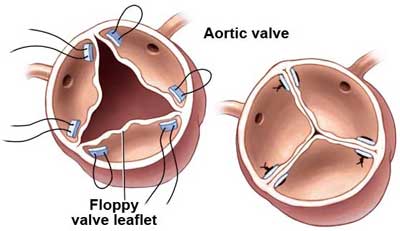Aortic Valve Repair Surgery
To help patients evaluate the treatment of aortic valve disorders, I created this page. So you know, the use of aortic valve repair techniques is relatively new. In the past, aortic valve disorders - including stenosis and regurgitation - were typically treated with heart valve replacement devices. Recently, however, new surgical techniques are being used and perfected to help patients preserve their own aortic valve without having to replace it.

Why Does My Aortic Valve Need To Be Repaired?
Let's start this discussion by learning more about the heart and the heart valves. The heart has four chambers, the atria and the ventricles. There are also four valves that regulate the flow of blood through the heart, keeping it moving in only one direction. The aortic valve is between the heart's left ventricle and the body's largest artery, the aorta.
In a normal aortic valve, three leaflets (also known as cusps or flaps) respond to changes in pressure to allow blood through and then close after the proper amount of blood has passed.
- If the aortic valve cannot open and close correctly, the patient may experience further complications that can be quite serious. An aortic valve can become stenotic, or narrowed, which limits or obstructs the movement of blood. Stenosis can result from calcium deposits accumulating on the cusps. A congenital heart defect, known as a bicuspid aortic valve, can also be problematic. In this condition, the individual is born with only two flaps on the aortic valve rather than the three flaps seen on a normal valve. So you know, I had a bicuspid valve prior to my surgery.
- If the aortic valve leaks blood back into ventricle, the ventricle must work harder to send the needed blood supply to the aorta. This condition is called aortic valve regurgitation or valvular incompetence. It is caused by the leaflets that cannot close as they should. It can result from aortic valve prolapse, a bicuspid aortic valve, endocarditis, an aneurysm, or from damages incurred from rheumatic fever.
Types of Aortic Valve Repair Surgery
Whenever possible, surgeons prefer to repair a damaged aortic valve rather than replace it. Aortic valve repair surgery is an open heart operation. This involves opening up the sternum, or breastbone (via median sternotomy), to provide access to the heart. Newer procedures are less invasive requiring smaller incisions, and in some cases, the operation can be performed through an incision between the ribs (known as port access or minithoracotomy), eliminating the need to divide the sternum.
The nature of the surgery needed, the aortic valve disorder, and the patient's health will determine which technique must be used. One of the most common aortic valve repair surgeries is done to reshape a bicuspid aortic valve. In this procedure, the surgeon can separate the leaflets that have been fused or surgically create a third leaflet. This repair can often be effected through minimally invasive surgery (a mini-sternotomy) which is primarily used for patients with aortic valve regurgitation.
In the past... Aortic valve repair was typically not recommended for patients with a stenotic bicuspid aortic valves. In younger patients, the surgeon may be able to remove the calcium deposits that are preventing the aortc valve from functioning properly. However, in older patients, the calcification may cause the flaps to become stiff and unyielding, making such cases impossible to remedy through a minimally invasive technique.
However, in 2019, there are new aortic valve repair techniques that make it possible for surgeons to repair valves with aortic stenosis and aortic regurgitation. I filmed this video with Dr. Vinay Badhwar, the Chief of Cardiac Surgery, at West Virginia University Medical Center, to discuss the latest trends in aortic valve repair surgery using the Ozaki procedure and the HAART 300 device.
In some patients, the problem with the aortic valve is a tear or hole in one of the leaflets. A cardiac surgeon can often patch such holes in the valve. The surgeon will use the patient's own tissue to create a patch if one is needed. Sometimes, the cords connecting the valve to the wall of the heart are either too long or too short to allow the valve to operate properly. Surrounding tissue that provides support for the valve may also weaken. Both problems can typically be repaired through surgery on the aortic valve.
Often, repairing an aortic valve involves treating an enlarged ascending aorta, the first section of the blood vessel leading from the valve. If the enlarged area, an aortic aneurysm, is less than four or five centimeters is diameter, the area can often be repaired. However, larger areas may require the weakened section to be replaced with a dacron graft.
Risks of Aortic Valve Repair Surgery
Aortic valve surgery is one of the most performed types of cardiac surgery. As such, overall risks are low, however, complications can arise and their can be challenges faced by the patient during the recovery from aortic valve repair or any cardiac procedure.
You should be comforted, however, that recent studies from The Society of Thoracic Surgeons suggest that mortality rates for aortic valve surgery is a little over 2 percent.
You May Also Like
To help you learn more about aortic valve repair surgery, you may like:
- Video: Advantages of Aortic Valve Repair with Dr. Lawrence Wei
- The HAART 300 Aortic Annuloplasty Device Gets FDA Approval for Aortic Valve Repair
- Bicuspid Aortic Valve: What Should Patients Know?
- Aortic Aneurysms & Heart Valve Disease
- Meet Aortic Valve Patients in Our Community
Page last updated: September 16, 2020




